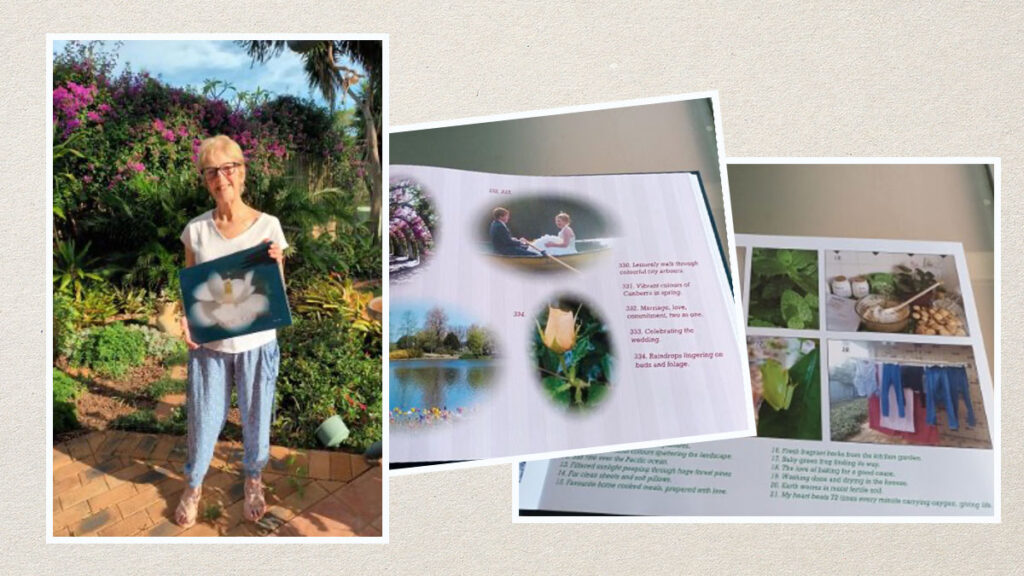Warning! Mathematics question ahead! This alert may leave some with a feeling of mild panic. If that is true, please don’t despair. Why? Because you can check your answer and your participation will be rewarded. Here is the critical knowledge you need: the angular measure between the floor and a vertical wall is 90 degrees. Let’s begin: What is your estimate of the angle measure between the two lines?

If your answer is about 45 degrees, you are correct. Well done! Now, before revealing the purpose of my question, I want to tell you about Robert Adams1—a photographer who documented the American West in more than 50 books of pictures. Robert grew up in Colorado and when his family moved to California, he saw a ”landscape of mistakes”. He thought this must be the worst place in the world, yet slowly he came to love the landscape he earlier hated. What made the difference? He began taking photos of the urban sprawl around him. Adams remarked, ”You could take pictures of suburban tract homes, which are in many ways inhumane, but they were showered with high-altitude sunlight that transformed them in ways that I can’t put into words.” He used the frame of his camera lens to create a coherent whole using the elements of the scene he was viewing. For Adams, the resulting wholeness in his pictures became a metaphor for wholeness in life.
Now I invite you to experience this process of reframing. Consider again the two lines presented at the start of this article. Let us add a few additional lines to create a new context. Do you see a representation of a three-dimensional box? If so, what angle measure do you now see between the two original lines?

If your answer is 90 degrees, you are correct. But wait. What just happened? How can the angle measure change from 45 to 90 degrees when the lines have not changed? Is maths always this confusing? The truth is this is not really about mathematics at all. It is about the power of perspective. Nothing about the two lines has changed except the context in which you viewed them.
I wonder if we can use this process of reframing to help perceive wholeness and beauty in life, just as Robert Adams uses his camera lens to reframe his photographic subjects.
While pondering such ideas, I encountered two ”re—” words that gave me a powerful insight. Firstly, what do I mean by ”re-” words? Consider this joke to illustrate.
A couple is having a baby soon. After learning they’re having a boy, the husband says, ”Let’s name him Pete!” But the wife says, ”Honey, we’re having twins.” The husband replies, ”Well, we can call the second RePete.”2
The ”re-” prefix adds the sense of ”again”. So, the word reframe means to frame again.
So, what are the two ”re—” words I want to share with you? The first of the words is resent. I was surprised to learn that resent literally means to ”feel again”. It derives from the Latin sentire, meaning to ”feel”. When someone hurts, annoys or criticises me, resenting the people or the situation is a natural response. I become aggrieved. I talk about it. Before long, it is ”eating me up”. When I resent, I feel it again and again. It’s like having a wound and repeatedly pulling off the scab. The wound never heals. It remains raw and causes me ongoing pain. How do you respond when someone hurts, annoys or criticises you?
The second word is respect. This word’s etymology means to ”look at again”. It derives from the Latin word specere, meaning ”look at”. From this word, we get words like spectacle. Respect is what Robert Adams demonstrated in his photography. He used his camera lens to look repeatedly at what was around him. And through such a process, he could see a beauty that he would otherwise have missed.
In the biblical book of Numbers, chapter 21, we encounter a story of the Israelites travelling south toward the Red Sea to go around the land of Edom. They had pleaded for permission to pass through the territory of the Edomites. ”Please let us pass through your country. We will not go through any field or vineyard, or drink water from any well. We will travel along the King’s Highway and not turn to the right or to the left until we have passed through your territory” (Numbers 20:17). Does that sound like a fair request? Sure. Even so, the Edomites refused and threatened war if the Israelites attempted the crossing. The Israelites tried to negotiate, saying, ”We will go along the main road, and if we or our livestock drink any of your water, we will pay for it. We only want to pass through on foot—nothing else” (Numbers 20:19). The Edomite refusal stood firm.
What did the Israelites do? They started resenting. They became short-tempered, impatient and aggrieved. Their frustration boiled over and they started attacking those nearest them—Moses and God. ”Why have you brought us up out of Egypt to die in the wilderness? There is no bread! There is no water! And we detest this miserable food!” (Numbers 21:5). Whoa! What was this miserable food? The food they detested was manna—the food God miraculously provided every morning to sustain them. Wow! Can you see what nursing resentment does? Ill feelings rage to the point where even the things that should inspire thankfulness become a part of our problem. Have you ever been in this place of resentment? I have. Sadly, too many times to count!
The Israelites needed a reality check—and fast! In this story, the reality check came from venomous snakes. These snakes bit the people and many Israelites died. The people regained their perspective about what was important and went to Moses and said, ”We sinned when we spoke out against God and you. Pray to God; ask him to take these snakes from us” (Numbers 21:7, The Message).
The solution was an interesting one. God told Moses, ”Make a snake and put it up on a pole; anyone who is bitten can look at it and live” (Numbers 21:8). Could God be saying, ”Choose to respect rather than resent? Choose to look again at your situation and see the blessings you receive daily rather than marinate in your ill feelings and perceived injustices, whether fair or not.”
Imagine if one of the Israelites had made a better choice and, instead of resenting the Edomite’s response to their request to shortcut through their land, looked at the situation again and said, ”That’s disappointing, but hey, isn’t it amazing that no matter how much farther we need to walk, we get to enjoy a good feed each day—and we don’t even need to carry it or grow it. Wow! Let’s go!” Imagine if that idea had rippled through the multitude!
This process of respecting—of looking again at a situation to see things in a better way—seems to be a tricky thing to master. Even the godly prophet Samuel had problems ”looking” at things the way God saw things. When Samuel was grieving over the fate of King Saul, God gave him a significant task. Samuel was sent to Jesse of Bethlehem to appoint one of Jesse’s sons as the new king. When Samuel saw Eliab, the eldest son, he thought, Wow! Surely this is the new king!
But God told Samuel, ”Looks aren’t everything. Don’t be impressed with his looks and stature. I’ve already eliminated him. God judges persons differently than humans do. Men and women look at the face; God looks into the heart” (1 Samuel 16:7, The Message). Isn’t that interesting? God looks into the heart—the part of us that represents the centre of our emotions—positive and negative—destructive and transformational. God discerns our struggles and inclinations and invites us to engage with life and love. This is the challenge of respect—to look again, to look in a new way, to look as God looks.
In our modern digital-based society, taking another look often means doing a Google search. However, as handy as a Google search can be, in some cases, the clever search filters may end up saying more about who I am and what I already believe rather than deliver worthwhile alternative perspectives. ”In Pariser’s (2011) TED talk, he says that at first the internet meant a connection to the world, something that brings everyone together, yet it is doing the opposite.”3
That seems to describe a movement away from respect and potentially toward resentment as we each protect what we believe is true based on what we hear in our personal or tribal echo chambers.
As challenging as things may be in what we see around us, I am heartened by the lives of those who choose to respect rather than resent. One such person is the late Father Bob McGuire. Radio personality John Safran said of Father Bob, ”He attracted all manner of outcasts, not all pleasant, but he was open-hearted to those people too. I asked him how [he] did this and he said, ’You don’t have to like people to love them’.”4 That’s respect! What will you choose more of today? Respect or resentment?
This question is not an appeal to throw away emotions and feelings in preference for an unfeeling clinical look. Feelings alone can be blind, yet a look without feeling can be cruel. Instead, this is an appeal to love—to see ourselves, others and situations in a new way. Just as 45 degrees with a flat view became 90 degrees with a three-dimensional view; perhaps we can practise looking again—respecting—to discern matters of the heart in ways that demonstrate compassion and empathy without resenting.
Just as Moses said to the Israelites: ”I have set before you life and death, blessings and curses” (Deuteronomy 30:19), let’s respond by committing to a better choice.
1. “Robert Adams: Photographing a ’landscape of mistakes’”, San Francisco Museum of Modern Art, <www.youtube.com/watch?v=XuhxlLv_f2k>, cited December 29, 2022.
2. <www.momjunction.com/articles/funny-baby-jokes-that-makes-you-laugh_00778032/>, Joke 93, cited June 25, 2023.
3. Kristen Allred, “The Causes and Effects of “filter bubbles” and how to break free” <medium.com/@10797952/the-causes-and-effects-of-filter-bubbles-and-how-to-break-free-df6c5cbf919f>, cited April 27, 2023.
4. Charlie Lewis, “Father Bob Maguire’s remarkable life was defined by a moral coherence our politicians lack”, Crikey Daily, April 20, 2023.
Craig Mattner is a Mathematics and photography teacher at Prescott College Southern in Adelaide, South Australia.






